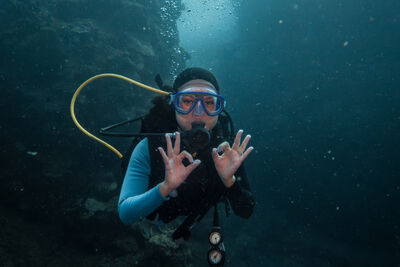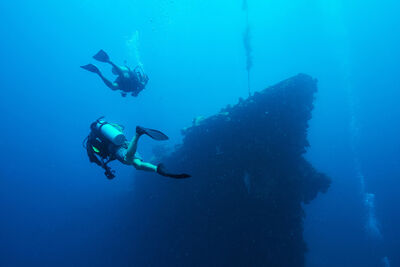Whether you're a seasoned diver or taking your first dip, mastering underwater communication is a crucial part of diving. Not only will it elevate every dive experience, but at the extreme end, it might just save your life (morbid, we know). From indicating critical problems to pointing out magical marine life, read on to discover the basic diving hand signals that every diver should know…

‘OK’ hand signal
First up is the most universal hand signal of them all: 'OK'. Even if you've never dived before, it's likely you'll still recognise this one. Underwater, it's used as both a question and an answer, for example, to ask if your dive buddy is okay, to respond that you're okay, to express understanding of something or to signal that you're ready.
‘Problem’ hand signal
This next signal is a pretty crucial one. Used to indicate any kind of problem underwater, the hand is held out flat, palm down, and rotated side to side. The gesture is commonly followed by pointing to the source of the problem, such as pointing to your ear if you're having trouble equalising.
‘Ascend/descend’ hand signal
For the uninitiated, diving hand signals can be a little confusing. A classic 'thumbs up' sign has a different meaning underwater - it signals that you're ascending to a safer depth, or up to the surface to end the dive. 'Thumbs down' underwater means (yep, you guessed it) that you're ready to descend from the surface, or that you're going to dive deeper.

‘Level off’ hand signal
The 'level off' signal is when your hand is held flat, palm down, and moved side to side horizontally. This is used to indicate that a diver wants to maintain their current depth, and is usually performed when ascending or descending, to express when they want to stop at a certain level.
‘Safety stop’ hand signal
Safety stops aren't mandatory on a dive but are highly recommended for safe diving practices. This hand signal is similar to the 'level off' one but includes three to five fingers extended vertically below the horizontal palm. The number of fingers indicates how many minutes the stop will be, which is typically performed just before surfacing at the end of the dive (at a depth of around five metres).
‘Low on air’ hand signal
Diving hand signals don't get much more important than these next two. Use this one if you need to indicate to your dive buddy that you're running low on air, so you can both safely ascend to the water's surface. If using bar measurements, this means whenever you have 50 bar left, or if using psi, it's when you have 500psi remaining.
‘I’m out of air’ hand signal
While it's (very) unlikely you'll ever need to use this emergency signal, it's a vital one to know. This will alert your buddy that you urgently need to share their air or use their alternate air source. Both divers should then ascend to safety and end the dive.

‘Look’ hand signal
Once you know this hand signal, you'll never miss a marine life sighting. Used by divers to show their buddy something underwater, the 'look' gesture involves pointing to their eyes, followed by pointing to the direction of interest, be it a wacky critter or kaleidoscopic coral formation.
‘Follow me’ hand signal
As the name suggests, this signal is performed when a diver wants you to follow them. The leader will use their index finger to point to themself, then move it in the direction they're going to travel (and where they want you to follow).
‘I don’t feel well’ hand signal
This is another critical diving hand signal that all divers should know. If you feel unwell underwater, point your fingers towards yourself and draw a large oval in front of your head and torso to alert your buddy.
















